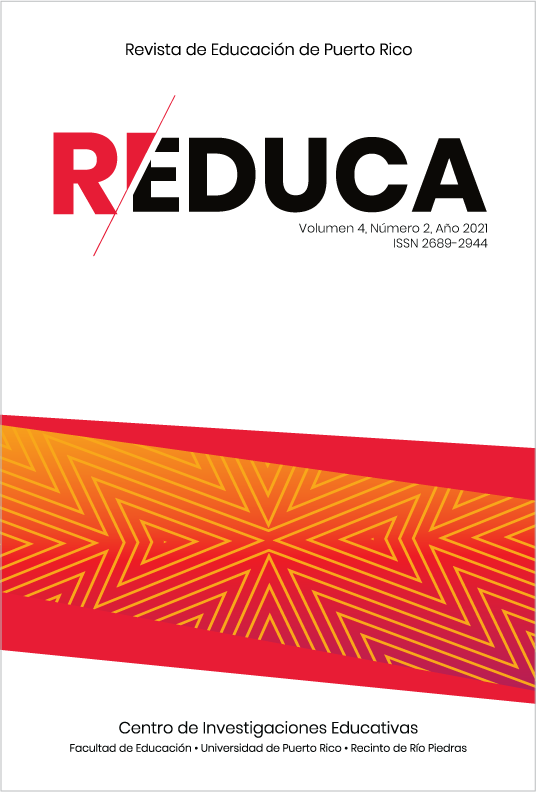Résumé
Los modelos teóricos de consejería constituyen la base sobre la cual se fundamentan las intervenciones en la relación de ayuda individual (Rosado Pacheco, 2014). La Terapia de Impacto (TI), un enfoque multisensorial y creativo, añade dinamismo a la sesión de consejería, lo que resulta en una intervención activa y efectiva tanto para el o la cliente, como para el o la profesional de ayuda. El aspecto multisensorial implica el uso de los sentidos —visual, auditivo, táctil y kinestésico— durante el proceso de consejería. La TI tiene como trasfondo varias teorías de consejería, como la Terapia Racional Emotiva de la Conducta (Ellis), el Análisis Transaccional (Berne), la Terapia Gestalt (Perls), la Terapia de la Realidad (Glasser) y la Psicología Individual (Adler). Este artículo explica el contexto y trasfondo para las intervenciones creativas, con ejemplos y conclusiones. Invita al profesional de ayuda a considerar las técnicas no-tradicionales en consejería en su repertorio profesional.
Références
Adler, A. (1956). The individual psychology of Alfred Adler. Basic Books.
Alwaqassi, S. A. (2017). The use of multisensory in schools today [Tesis de maestría]. Indiana University. http://core.ac.uk/download/pdf/213849538.pdf
American Counseling Association (ACA). (2009). The ACA Encyclopedia of Counseling.
American Counseling Association. (2014). ACA Code of ethics. https://www.counseling.org/Resources/aca-code-of-ethics.pdf
Beaulieu, D. (2006). Impact techniques for therapists. Routledge.
California Department of Education (CDE). (2017, sep. 11). Research on school counseling effectiveness. https://appservice.caiu.org/GetDocument?folderPath=CP%5CResouceBank%5C&filename=Student%20to%20Counselor%20Ratio%203.pdf
Christie, S. (2000). The brain: Utilizing multi-sensory approaches for individual learning styles. Education, 121(2), 327-330.
Davis, D. (s.f.). REBT in the context of modern psychological research. The Albert Ellis Institute. https://albertellis.org/rebt-in-the-context-of-modern-psychological-research/
Ginter, E. J., Roysircar, G. & Gerstein, L. H. (2019). Theories and applications of counseling and psychotherapy: Relevance across cultures and settings. Sage Publications.
Hazler, R. J. & Barwick, N. (2001). The therapeutic environment: Core conditions for facilitating therapy. Open University.
Hoisington, B. (2015). Multisensory activities to teach reading skills. Minnesota Literacy Council. https://www.literacymn.org/multisensory-activities-to-teach-reading-skills
Jacobs, E. (1994). Impact therapy. Psychological Assessment Resources.
Jacobs, E. (2013, julio 12-14). Impact Theory: Putting theories into practice [Taller intensivo]. Star City, West Virginia.
Jacobs, E., & Schimmel, C. J. (2012). Impact therapy: The courage to counsel. Impact Therapy Associates.
Kaplan, D. M., Tarvydas, V. M. & Gladding, S. T. (2014). 20/20: A vision for the future of counseling: The new consensus definition of counseling. Journal of Counseling & Development, 92(3), 366-372. https://www.counseling.org/docs/default-source/20-20/2020-jcd-article.pdf?sfvrsn=c9897d2c_2
Landmark School Outreach. (s.f.). Use of multisensory approaches. Landmark School. https://landmarkoutreach.org/strategies/use-multisensory-approaches/
Laghi, F., Crea G. & Filipponi, C. (2020). Evaluation and measurement of ego states: The Psychometric Properties of the Italian translation of the revised version of the Ego State Questionnaire (ESQ-R). International Journal of Transactional Analysis Research and Practice, 11(2),14-24. https://doi.org/10.29044/v11i2p14
Lambert, M. J. & Cattani-Thompson, K. (1996). Current findings regarding the effectiveness of counseling: Implications for practice. Journal of Counseling & Development, 76(6), 601-608. https://doi.org/10.1002/j.1556-6676.1996.tb02299.x
León, L., & Grajales, S. (2001). Estilos de vida. Convención de la Asociación Puertorriqueña de Consejería Profesional (APCP). Río Grande, Puerto Rico.
MacDonald, T. (2014). Motivating the unmotivated student. En R. Byrd & B. Erford (Eds.), Applying techniques to common encounters in school counseling (pp. 100-105). Pearson.
Mulhauser, G. (n.d.). Evaluating therapeutic effectiveness in counseling and psychotherapy. Counselling Resource. https://counsellingresource.com/therapy/types/effectiveness
Morin. A. (s.f.). Multisensory Instruction: What you need to know. Understood. https://www.understood.org/articles/en/multisensory-instruction-what-you-need-to-know
Murphy, L. J. (2012). The impact of birth order on romantic relationships [Tesis de Maestría en Consejería y Psicoterapia Adleriana]. Adler Graduate School. https://alfredadler.edu/library/masters/2012/lyndsie-j-murphy
Nystul, M. S. (2015). Introduction to counseling: An art and science perspective (5ta. ed.). Sage.
Perls, F. (1969). Gestalt therapy verbatim. Real People Press.
Raffagnino, R. (2019). Gestalt therapy effectiveness: A systematic review of empirical evidence. Open Journal of Social Sciences, 7, 66-83. http://doi.org/10.4236/jss.2019.76005
Rogers, C. R. (1951). Client-centered therapy. Houghton Mifflin.
Rogers, C. R. (1957). The necessary and sufficient conditions of therapeutic personality change. Journal of Consulting Psychology, 21(2), 95-103. http://dx.doi.org/10.1037/h0045357
Rogers, C. R. (1980). A way of being. Houghton Mifflin.
Rosado, Pacheco C. M. (2010, abril 10). Terapia de Impacto: Creatividad al servicio del consejero [Conferencia]. Asociación Puertorriqueña de Consejería Profesional (APCP), Pontificia Universidad Católica de Puerto Rico, Recinto de Ponce.
Rosado Pacheco, C. M. (2013a). Articulando la teoría y la práctica con la Terapia de Impacto. DEG Informa, 17, 18-20.
Rosado Pacheco, C. M. (2013b, julio 10-15). Shadowing experience with Dr. Ed Jacobs, Impact Therapy founder. Purpose: The study and in-depth application of Impact Therapy [entrenamiento]. Star City, West Virginia.
Rosado Pacheco, C. M. (2014). La consejería: Arte, ciencia y profesión de ayuda (2da ed.). Publicaciones Puertorriqueñas.
Rosado Pacheco, C. M. (2015). Adiestramiento profesional en Terapia de Impacto. [Manuscrito inédito]. Universidad de Puerto Rico, Recinto de Río Piedras.
Saadati, H. & Lashani, L. (2013). Effectiveness of Gestalt Therapy on self-efficacy of divorced women. Procedia-Social and Behavioral Sciences, 84, 1171-1174. https://doi.org/10.1016/j.sbspro.2013.06.721
Segal, U. A. (2011). Progressive relaxation and cognitive desensitization. En H. G. Rosenthal (Ed.), Favorite counseling and therapist techniques: 51 therapists share their most creative strategies (2da. ed., pp. 267-272). Routledge.
Seligman, L. & Riechenberg, L. W. (2014). Theories of counseling and psychotherapy: Systems, strategies, and skills (4ta. ed.). Pearson.
Sharf, R. (2016). Theories of psychotherapy and counseling: Concepts and cases (6ta. ed.). Brooks/ Cole–Cengage Learning.
Shaw, S. (2020, marzo 10). Learning from high effective counselors. Counseling Today. https://ct.counseling.org/2020/03/learning-from-highly-effective-counselors/
Sommers-Flanagan, J. & Sommers-Flanagan, R. (2018). Counseling and psychotherapy theories in context and practice: Skills, strategies and techniques (3ra. ed.). John Wiley and Sons.
Sperry, L., Carlson, J. & Kjos, D. (2003). Becoming an effective therapist. Allyn & Bacon.
Stoffers, M. (2011). Using a multi-sensory teaching approach to impact learning and community in a second grade classroom [Tesis de maestría]. Rowan University. https://rdw.rowan.edu/cgi/viewcontent.cgi?article=1109&context=etd
Vahidiborji G., Jadidi M. & Donyavi, R. (2017). The study of effectiveness of Reality Therapy on adjustment of female adolescent with anxiety. Journal of Psychology and Clinical Psychiatry, 7(1). https://doi.org/10.15406/jpcpy.2017.07.00414
Wubbolding, R. E. (2000). Reality therapy for the 21st century. Brunner-Routledge.
Wubbolding, R. E. (2017). Reality therapy and self-evaluation: The key to client change. American Counseling Association.

Ce travail est disponible sous licence Creative Commons Attribution - Pas d’Utilisation Commerciale 4.0 International.

